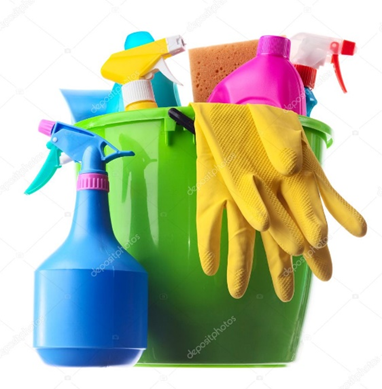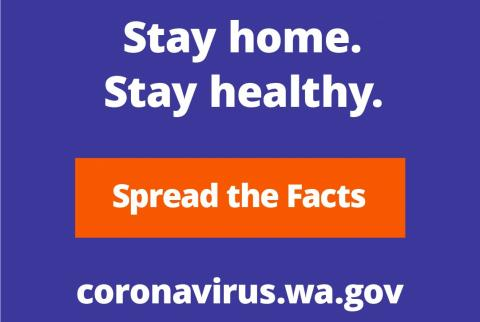Published on:
Even the most meticulous house cleaners are likely worried about the best ways to protect their homes and loved ones during the coronavirus pandemic.
The publishers at Home Ownership Matters, a resource for current and future homeowners produced by the National Association of Realtors® (NAR) gathered tips from medical reports and health care professionals on the easiest ways to fight off the common flu as well as COVID-19.
Medical care professionals agree that simple precautions taken continuously can drastically help combat the coronavirus and germs in general. Here are their top 10 tips:
1. CAREFULLY READ CLEANING PRODUCT CLAIMS
Shopping for cleaning products can be overwhelming. With shelves jam-packed with a variety of options, it’s tough to find the right product for you and your home. Many products proudly exclaim they are “anti-bacterial,” although that doesn’t necessarily mean they disinfect surfaces properly. The Environmental Protection Agency (EPA) has compiled a list of 500 products that they guarantee will disinfect all areas against viruses such as the coronavirus. When stocking up on cleaning supplies, look for labels that the EPA has tested and approved with words “disinfect” and “sanitize.” If you prefer to be chemical-free, numerous all-natural products can kill microbes, such as tea tree oil, lemon juice, and vinegar. While these products will certainly help eliminate germs from your home, they work much slower than their chemical counterparts. Microbiologist Charles Gerba of the University of Arizona explains that these options kill fewer microorganisms than those that have been approved by the EPA.
2. INCREASE HUMIDITY
Increasing the humidity in your home can not only help you breathe with more ease during the harsher winter months, but it can also make it more difficult for bacteria and COVID-19 to grow and develop. Creating an environment that doesn’t allow germs to thrive will create a safer home for yourself and protect you from the dreaded coronavirus. Humidifiers can also aid symptoms for those with a cold or COVID-19. It’s very important to keep humidifiers clean. This is one household item that is often overlooked when cleaning. As humidifiers add moisture to the air, they can also quickly generate bacteria. Barney Burroughs, the president of Building Wellness Consultancy, recommends regular cleaning of individual humidifiers and having the entire system serviced once a year, preferably when they aren’t in use in the warmer seasons.
3. REPLACE YOUR SPONGES
Sponges are a “bacteria hotbed.” Regularly replacing your sponges is a small task with big benefits. Kitchen sponges hold a tremendous amount of bacteria, even with frequent use with soap and hot water. Replace sponges every few weeks to ensure no bacteria is lingering around your sink and dishes.
Alternatively, toss sponges in the dishwasher or microwave it for one minute. These options will reduce the bacteria living in your sponge. Heat can help eliminate the most dangerous bacteria, but it cannot kill all of the billions of types of bacteria that hides in a sponge. As Jennifer Quinlan a food microbiologist at Drexel University explains, “It doesn’t sterilize the sponge…but remember, the bacteria we want to kill are the ones that will make you sick.”
4. DON’T JUST PUSH GERMS AROUND, ELIMINATE THEM
Many cleaning tools give the impression they are killing germs and cleaning when in reality they are simply spreading germs to more hidden areas of your home. The only way to avoid this is by sanitizing cleaning tools such as mops, dusters, and dishrags between uses or they will continue to spread bacteria around your house. This often goes unnoticed, as some of the most sparkling clean homes can be saturated with bacteria while other less tidy homes test low for germs because said germs sit still rather than spread from wall to wall. Dishrags and other non-disposable towels are a more environmentally conscious tool than paper towels, but only if they are continuously washed at high temperatures to kill pesky germs. Charles Gerba, co-author of The Germ Freak’s Guide to Outwitting Colds and Flu, says “It’s a free ride for the virus.”
5. SANITIZE fREQUENLY TOUCHED SURFACES
While at home, many surfaces are touched constantly, including doorknobs, light switches, remotes, refrigerator and stove handles and more. Flu viruses can live for two to eight hours on these hard surfaces, so it’s crucial to frequently disinfect these areas. Any cleaning wipes or products that say “sanitizing” on the label will work fine to catch those troublesome germs.
6. STOCK UP ON TISSUES
For many people, tissues aren’t a go-to purchase at the market until hit with a cold. Stocking up on tissues is one way to help keep your home germ-free. One sneeze can spray an assortment of germs up to 6 feet, and they’re likely to linger for hours if not days. Research from the University of Bristol shows that the “average sneeze or cough can send around 100,000 contagious germs into the air at speeds up to 100 miles per hour.” Using a handy tissue to sneeze or blow your nose will confine those germs.
7. WASH YOUR LINENS
Of course you wash your towels, sheets, and dish rags every now and then, but it’ likely not often enough. As soon as you step out of the shower and dry off with your towel, you’re spreading thousands of germs and bacteria onto yourself. While your towel hangs in your bathroom, persistent germs latch onto your linens and grow – even droplets from your toilet. While these microbes aren’t guaranteed to get you sick, they can rapidly multiply. Microbiologist Philip Tierno at NYU School of Medicine explains that a damp towel has growing bacteria and “Wherever there is odor, there are microbes growing, so it should be washed.” Bedsheets are also a breeding ground for germs. From lint to skin cells, your sheets are covered in a variety of germs and allergens that can negatively impact your health. Tierno recommends washing bed linens at least once a week to avoid the growth of these microbes.
8. STOP ABIDING BY THE “3-SECOND RULE”
We all remember the socially acceptable rule we learned in elementary school – the “3-second rule” – that made everyone feel better about eating food off the floor. Floors are swarming with viruses and bacteria (ick!) so you should not eat anything that touches it. As microbiologist Tierno said “If you drop some food stuff there [on the floor], don’t eat it…a lot of people do stupid stuff, and they have the three second rule, which is nonsense.” Unless you’re sanitizing your floor every few minutes, eating any food that has touched it is clearly a bad idea. When you pick a chip up off the floor, for example, you may believe you’re only taking in your own germs and will probably think something along the lines of, I just mopped the other day, my floors are clean. Although, anything that has hit the floor will become covered in germs that have been tracked in from the outside world. Another important factor to remember: just because you don’t see germs, doesn’t mean they aren’t there.
9. DEEP CLEAN FLOORS AND CARPETS REGULARLY
It’s easy to center deep cleaning when things become visibly dirty, but by putting cleaning off you’re allowing germs to multiply. Rather than waiting for a big spill to hit your hardwood floor, get in the habit of steaming your wooden floors and deep cleaning rugs and carpets about every month. Hardwood floors harbor bacteria from outside that remain until the area is properly disinfected. Floors in or near the kitchen are especially important to focus on, as germs from food (raw chicken is the #1 worst culprit) are dangerous.
Studies from Clemson University’s Department of Food Science and Human Nutrition have found that hazardous pathogens with the potential to cause severe internal infections such as E. coli, campylobacter, and salmonella can survive on hard surfaces for days. Rugs and carpets should be cleaned regularly as they attract and hold a great deal of debris. Carpets can contain up to 200,000 bacteria for every square inch, making it “4,000 times grosser than your toilet,” wrote Heather Barnett in SheKnows.
10. SPLURGE ON GERM-FIGHTING APPLIANCES
If you’ve been in the market for a new dishwasher or washing machine, take time to research appliances that have been tested and certified by NSF International, an independent, not-for-profit noni-governmental public health and safety organization, formerly known as National Sanitation Foundation. NSF has certified several appliances that focus on fighting germs and keeping homes healthy and safe. Their Home Product Certification Program aids consumers in identifying the safest products for their home. NSF’s extensive testing is specific to home use and balances the product’s performance, quality, and food contact material regulations.
Germs are omnipresent so it is important to protect ourselves as much as possible. Conversely, being too clean isn’t necessarily a saving grace. Not all germs are harmful, so there is no need to become germophobic.
 By being proactive in keeping yourself healthy and happy, you’ll likely never become infected with coronavirus. Methods to stay coronavirus-free this season are very effective and mostly hassle-free. As Tierno says, “You’ve just got to be wise, be aware, and understand your surroundings. It’s not brain surgery.”
By being proactive in keeping yourself healthy and happy, you’ll likely never become infected with coronavirus. Methods to stay coronavirus-free this season are very effective and mostly hassle-free. As Tierno says, “You’ve just got to be wise, be aware, and understand your surroundings. It’s not brain surgery.”
Guidelines and protocol surrounding COVID-19 are changing quickly. For the most up-to-date information visit the CDC, WHO, and within Washington state, the Coronavirus Response (COVID-19) website.
Northwest REporter acknowledges Home Ownership Matters for most of the content in this article.

How to sanitize electronic devices

For tips on keeping electronic devices such as phones, tablets, and laptops clean and sanitized, refer to resources published by Consumer Reports.